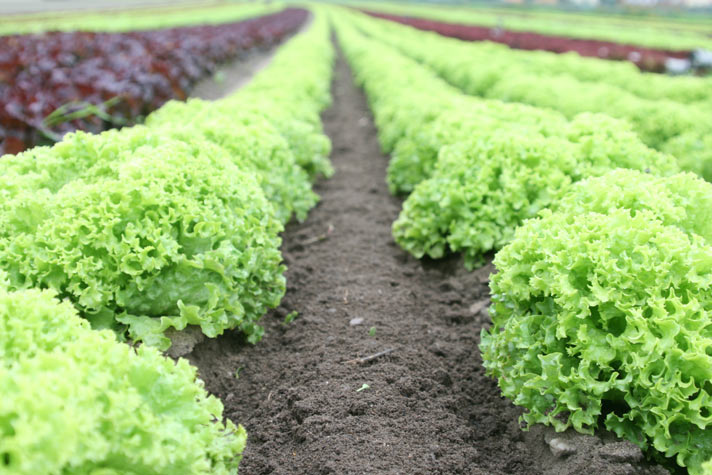The Literary Gardener – February 2017
I eat a lot of salad, so I derive particular pleasure from growing some of the lettuces I consume. There are so many varieties to choose from: crispheads, butterheads, looseleafs and Romaines, not to mention fancy designer greens such as endive and arugula.
In fact, all of our modern lettuces (Lactuca sativa) are cultivars of wild lettuce (Lactuca serriola), which originated in regions of the Mediterranean and the Middle East. A member of the daisy family, wild lettuce is a prickly, bitter-tasting plant, nowadays cursed by Oregon farmers as a pesky weed that competes with their cereal crops. However, ancient Egyptians revered lettuce for its oily seeds, and its milky sap (thus the genus name Lactuca) that was thought to be an aphrodisiac. Accordingly, the Egyptians dedicated lettuce to Min, god of fertility.
Romaine is one of the oldest lettuce cultivars, depicted in Egyptian art dating back to the third millennium BCE. Romaine lettuce was particularly cultivated in Syria where it was used as a scoop for tabbouleh.
By 50 CE, the Romans had noted that the milky substance in lettuce seemed to induce sleepiness, so they served it at the end of a meal as a sort of vegetable nightcap. Indeed, modern-day science has confirmed that the latex in lettuce contains a small amount of organic alcohols. According to legend, the Roman Emperor Dimitian (81-96 CE) switched to serving lettuce at the beginning of a meal as a way to torture his guests who dared not fall asleep in the emperor’s presence. Dimitian was certainly a horrible dinner host, but his antics initiated the common practice of serving salad before the dinner entrée.
Caesar Augustus, who ruled Rome from 27 BCE until his death in 14 CE, was said to have built a statue in honor of lettuce because he was convinced that it had cured him of a serious illness. Today, we have him to thank for our Caesar salads. In fact, the mild narcotic properties of lettuce have long been utilized in folk medicines for pain, rheumatism, tension and nervousness.
Whereas the Egyptians once thought of lettuce as green Viagra, the ancient Greeks linked lettuce with impotency because lettuce must be prevented from going to seed in order to be edible. In Greek mythology, Aphrodite, goddess of love and fertility, tried to protect her young lover, Adonis, from a wild boar by hiding Adonis in a bed of lettuce. The myth initiated an expression: “Barren as the gardens of Adonis.” Alas, Adonis was killed anyway and became a symbol of youthful male beauty and death before reaching maturity. During the Greek summer festival called Adonia, young girls re-enacted Adonis’ untimely death by planting lettuce; also, lettuce is traditionally served at Greek funerals.
Lettuce has been featured in a number of literary works. In Shakespeare’s “Othello” (1604), Iago, the main antagonist, speaks out, “Our bodies are our gardens, to which our wills are gardeners: so that if we will plant nettles, or sow lettuce…why, the power and corrigible authority of this lies in our wills…” And in Shakespeare’s “Antony and Cleopatra” (1606), Cleopatra laments her “salad days, when I was green in judgment….”
In the classic adventure novel, “Watership Down” by Richard Adams (1972), Chapter 15 tells the story of King Darzin’s prized lettuce garden “surrounded by a deep ditch and guarded by a thousand sentries day and night.” Even with such protection, the clever rabbit leader, El-ahrairah, and his sidekick, Rabscuttle, steal the king’s lettuce and win their release from exile in the marshlands. The story ends, “And from that day to this, no power on earth can keep a rabbit out of a vegetable garden…”
This was certainly the case in “The Tale of Peter Rabbit” and other beloved children’s stories written and illustrated by Beatrix Potter. In “The Tale of the Flopsy Bunnies” (1909), Potter refers to the soporific quality of lettuce. After finding a pile of overgrown lettuce in Mr. McGregor’s rubbish heap, the “Flopsy Bunnies simply stuffed lettuces. One after another, they were overcome with slumber, and lay down in the mown grass.” In the story, Potter admits, “I have never felt sleepy after eating lettuces, but then I am not a rabbit.”
Sleep inducing or not, and despite rabbits, deer, snails, and other unwelcome lettuce lovers, many gardeners (myself included) wouldn’t think of having a garden without lettuce. In fact, a 15-foot row of lettuce planted in successive sections will feed a family of four throughout the growing season.
If you haven’t been growing lettuce in a cold frame already this winter, February is a good time to start sowing lettuce seeds indoors before transplanting the seedlings into the garden come spring. Sow more seeds every two weeks for successive crops. Lettuce seeds are tiny, so try pelleted seeds for more accurate sowing and less thinning out after germination. Once in the garden, head lettuces should be spaced 8-10 inches apart; leaf lettuces can be grown about 4-5 inches apart. Also keep in mind that lettuce seeds have a short shelf life, so use up the seeds this year or share them with other gardeners.
Because lettuce is a cool-weather crop, I had a hard time preventing my lettuce from bolting until I started growing it in containers. Now when the weather warms up, I can move my lettuce to cooler spots; this way, I’ve been able to harvest leaf lettuce until June. Other gardeners protect lettuce from bolting by covering the rows with shade cloth.
Whether in rows or containers, lettuce likes moist, well draining, fertile soil with lots of nitrogen, so be sure to add compost to the planting hole and supplement with a balanced fertilizer throughout the growing season. For leaf lettuces, harvest the outer leaves to encourage new growth.
In 2015, a red variety of Romaine lettuce called “Outredgeous” was the first food to be planted, grown, harvested and eaten in outer space. From ancient Egypt to the International Space Station, lettuce has certainly come a long way in the last 5,000 years. Who knows what the future holds for this historical plant?

 Rhonda Nowak is a teacher, writer and gardener who lives and works in the Rogue Valley. She has taught literature and language arts for 25 years, the last six at Rogue Community College. In addition to her column for the Jacksonville Review, she writes a weekly column and blog called the Literary Gardener for the Mail Tribune. She also writes articles for Southern Oregon Wine Scene magazine and is writer and editor of Ashland Living magazine. Email Rhonda at Rnowak39@gmail.com.
Read more on her blog at
Rhonda Nowak is a teacher, writer and gardener who lives and works in the Rogue Valley. She has taught literature and language arts for 25 years, the last six at Rogue Community College. In addition to her column for the Jacksonville Review, she writes a weekly column and blog called the Literary Gardener for the Mail Tribune. She also writes articles for Southern Oregon Wine Scene magazine and is writer and editor of Ashland Living magazine. Email Rhonda at Rnowak39@gmail.com.
Read more on her blog at